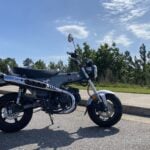Remembering LA’s Iconic Sixth Street Viaduct
Not far from the quasi-bohemian Arts District of downtown Los Angeles, the defeated remains of a beloved bridge are mourned. The Sixth Street Bridge’s mighty 30-foot reinforced concrete pylons stood as sentinels of the city gates. This area of Downtown LA remains a kind of urban frontier, the frayed edge of a city that seems neither alive nor dead, a shadowy place that draws motorcyclists and adventurers to its wild concrete canyons. Some long-abandoned brick warehouses and factories are now living spaces, bars and no one is quite sure what else; others house only past lives and bad dreams. If you like riding on the edge, this is home.
As a rider of many a steel span, the art deco-era 6th Street Bridge was long one of my favorites. There is something about hurling yourself through the air while over water that feels like medieval wizardry. Being a native New Yorker, the Brooklyn, George Washington and Verrazano Bridges were engineering miracles we took for granted, zooming over them in a mad dash to points unknown.
Remember this from movies and television? Of course you do. Photo by A Syn.
Except for the 59th Street Bridge, otherwise known as the Ed Koch Queensboro Bridge, after the dearly departed NYC mayor. Mostly, I just recall it as that damn bridge where my 1981 Shovelhead stroker overheated in bumper-to-bumper traffic one sweltering summer day—on an incline. I pushed the cantankerous beast uphill for what felt like at least 100 yards. Or it may have been 10, hard to tell when you’re passing out. No one dared honk or curse, seeing I was one heat-crazed biker in a mood, humping this 800-something pound mass of hot metal and bad attitude over a damn bridge. Got to the crest of the Queensboro and coasted downhill. Gently came to a rest at the first light and holy crap, the old Shovel roared back to life. Or maybe it was more of a meow. Either way, it got me home.
The 6th Street Bridge was a more friendly span. Long a kind of film noir star of many a movie, commercial, TV show, music video, and photo shoot, it has now faded forever to black. The bridge, also known as the Sixth Street Viaduct, has gone the way of Route 66, eroding into history and American nostalgia. An era has crumbled.
So many films, shows and music videos have been shot on, under, or around this bridge, it became a star in its own right. Who could forget this famous scene from Grease (1979)?
Once spanning the Los Angeles River, multiple railroad tracks, U.S. 101, and several local streets, the bridge was a scene-stealer in such car lover flicks as Hot Rod Girl (1956), Gone in 60 Seconds (2000), Drive (2011) and Furious 7 (2015), among countless others. It also linked generations of filmmakers who saw the artful structure as a connection to the city’s gritty zeitgeist.
The 3,500-foot landmark lasted a lifetime. At 84-years-old and reinforced with ancient square rebar and hung with steel arches, it was the longest of 14 historic Los Angeles River crossings, connecting the Arts District to Boyle Heights west to east via Sixth Street and Whittier Boulevard. Although built with 1932’s latest engineering technologies, the concrete bridge began deteriorating prematurely, only 20 years after it opened. A chemical process known as an alkali-silica reaction, which created cracks in the cement, was eroding the structure. Costly attempts were made to correct the problem, but all were met with limited success. Restoration attempts proved to have only a Band-Aid effect, yet previous plans to scuttle the bridge and build a replica didn’t go far. Los Angeles city officials, citing seismic studies, reluctantly deemed the decaying structure lacked the integrity to withstand a major earthquake, in addition to other safety concerns.
Portions of Terminator 2: Judgement Day (1991) were shot in the 6th Street Viaduct district. Its also where the world first fell in love with the Harley-Davidson Fat Boy.
In a kind of hipster expression of bridgework, the new span will feature 10 pairs of curved arches in a kind of modern “wave” design, the plan of architect Michael Maltzan. The earthquake-resistant “Ribbon of Light” came with a $449 million price tag, but that has since risen to over $588 million, of course. Completion was expected in 2019; the pandemic had other plans. The ribbon is now expected to be cut summer of 2022.
New open spaces, parks and community amenities were attached to Maltzan’s design, which involved input from local residents, bicyclists, activists, public and private sector leaders, labor unions, and artists, among others (Sadly, as far I know, no bona fide motorcyclists were consulted.). A city councilman commented such a level of collaboration in an infrastructure project is unprecedented. This could also be seen as a project of continual compromise that will be mightily challenged to fill the cultural void left by an historic landmark indelibly stamped into film, television and memory. Hundreds of sentimental supporters poured over and around the bridge the night before the first phase of demolition back in 2016. Angelenos in hotrods, muscle cars, low riders, motorcycles, skateboards, bicycles and naturally in beachy flip-flops gave one last salute to the condemned icon.
The plan for the new span. Impressive, but just not the same. Photo by LA Bureau of Engineering.
As Los Angeles grew around it, there was something reassuring about the bridge that flowed beyond its purpose. It had that bygone character and style, a survivor through good and hard times, much like the neighborhood anchoring its columns. As efficient and sterile glass and steel skyscrapers rose from urban streets, the bridge was a steadfast reminder of when art and craftsmanship combined with human toil to build something significant and pragmatic, yet aesthetically pleasing.
The bridge cast a furtive shadow on the streets below, mostly grimy brick warehouses and long-disused factories, now awaiting the inevitable encroachment of gentrification. The new bridge will not trumpet the gateway to downtown as much as it will signal the vanishing underbelly of Los Angeles. That grit and edge, the “low-rent” area, if any such place exists in SoCal, where artists and writers and musicians might find community, that so-called barren place where the creative fertility of a city births ideas, may soon be lost with its concrete icon. I suppose that’s progress—but culturally I’m not too thrilled.
J. Joshua Placa
Beloved and much missed. Photo by Motor Trend.




























0 Comments